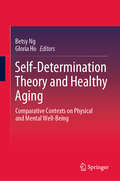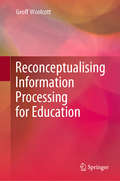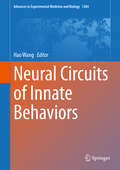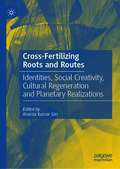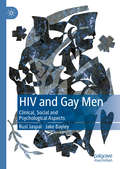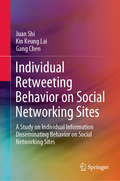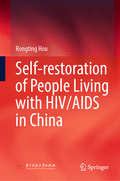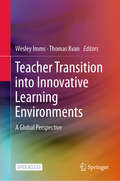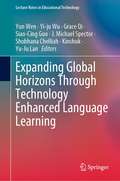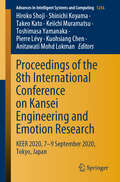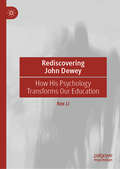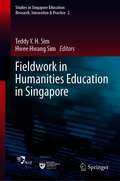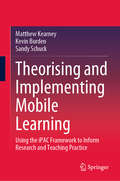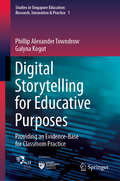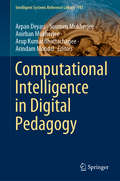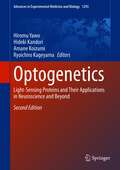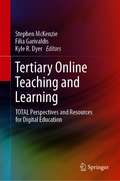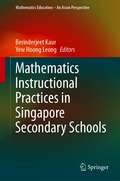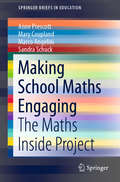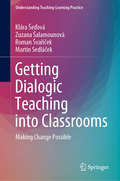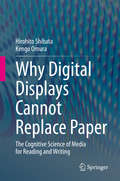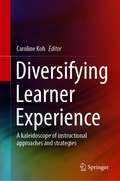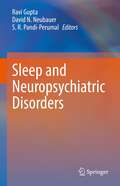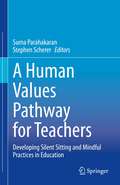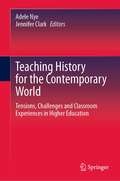- Table View
- List View
Self-Determination Theory and Healthy Aging: Comparative Contexts on Physical and Mental Well-Being
by Betsy Ng Gloria HoThis book pioneers evidence-based research on healthy aging through the application of self determination theory (SDT). Its uniqueness is located in the fact that to date, no other work has applied SDT to the empirical study of aging populations. The authors focus on how SDT drives healthy, successful and active aging, and note that the motivation factors underpinning healthy aging are often neglected, or altogether absent, in the existing literature. This edited volume is particularly timely given the expanding aging crisis in many North American, European and Asian contexts. The collection of chapters meets this challenge head-on in comparing these contexts vis-a-vis a broad international scope, and subsequent discussions on important specialty issues in aging, such as hearing and memory loss. The work offers global perspectives on aging, autonomy and associated life challenges, as well as factors relating to the sustainability of healthy aging in terms of physical and mental well-being. This book will be highly relevant to researchers in the SDT community, as well as specialists in aging and gerontology. It will also be of interest to lifespan psychologists and developmental psychologists.
Reconceptualising Information Processing for Education
by Geoff WoolcottThis book presents a novel conceptualisation of universal information processing systems based on studies of environmental interaction in both biological and non-biological systems. This conceptualisation is used to demonstrate how a single overarching framework can be applied to the investigation of human learning and memory by considering matter and energy pathways and their connections. In taking a stance based on everyday interactions, as well as on scientific practices, the conceptualisation is used to consider educational theories and practices, exemplified by the widely cited cognitive load theory. In linking these theories and practices more closely to scientific thinking, the book embraces an holistic approach to informational interactions, not limited to conceptualisations of pattern, signal or meaning. The book offers educational researchers and educators an opportunity to re-think their approach to instruction – to take all facets of student learning environments into account in increasing human knowledge, skills and experiences across society.
Neural Circuits of Innate Behaviors (Advances in Experimental Medicine and Biology #1284)
by Hao WangThis book summarizes the latest research findings in the neurocircuitry of innate behaviors, covering major topics such as innate fear, aggression, feeding, reward, social interaction, parental care, spatial navigation, and sleep-wake regulation. For decades, humans have been fascinated by wild animals’ instincts, like the annual two-thousand-mile migration of the monarch butterfly in North American, and the “imprint” behavior of newborn birds. Since these instincts are always displayed in stereotypical patterns in most individuals of a given species, the neural circuits processing such behaviors must be genetically hard-wired in the brain. Recently, with the development of modern techniques, including optogenetics, retrograde and anterograde virus tracing, and in vivo calcium imaging, researchers have been able to determine and dissect the specific neural circuits for many innate behaviors by selectively manipulating well-defined cell types in the brain. This book discusses recent advances in the investigation of the neural-circuit mechanisms underlying innate behaviors.
Cross-Fertilizing Roots and Routes: Identities, Social Creativity, Cultural Regeneration and Planetary Realizations
by Ananta Kumar GiriThe book discusses how we can cross-fertilize relationship between roots and routes with and beyond the logic of closure, monological assertions and violence. The book draws upon multiple philosophical, historical, religious and spiritual traditions of the world to rethink our conceptions and productions of identity as well as our conventional understanding of roots and routes. The book particularly explores the vision and practice of creativity, socio-cultural regeneration and planetary realizations to cultivate new pathways of identity realization and new relationship between identities and differences in our fragile world today. Trans-disciplinary in engagement and trans-civilizational in its dialogical pathway, the book is a unique contribution to our contemporary scholarship about ethnicity, identity, social creativity, cultural regeneration and planetary realizations.
HIV and Gay Men: Clinical, Social and Psychological Aspects
by Rusi Jaspal Jake BayleyThis book focuses on the clinical, social and psychological aspects of HIV among gay men and examines the complex factors that can contribute to HIV risk in this key population. With the target to end all HIV transmissions in the UK by 2030 in mind, Jaspal and Bayley combine elements of HIV medicine and social psychology to identify the remaining barriers to effective HIV prevention among gay men. The authors take the reader on a journey through the history of HIV, its science and epidemiology and its future, demonstrating the vital role of history, society and psychology in understanding the trajectory of the virus. Underpinned by theories from social psychology and clinical snapshots from practice, this book considers how psychological constructs, such as identity, risk and sexuality, can impinge on physical health outcomes. This refreshing and thought-provoking text is an invaluable resource for scholars, clinicians and students working in the field of HIV.
Individual Retweeting Behavior on Social Networking Sites: A Study on Individual Information Disseminating Behavior on Social Networking Sites
by Juan Shi Kin Keung Lai Gang ChenThis book explores and analyzes influential predictors and the underlying mechanisms of individual content sharing/retweeting behavior on social networking sites (SNS) from an empirical perspective. Since Individual content sharing/ retweeting behavior expedites information dissemination, it is a critical mechanism of information diffusion on Twitter. Individual sharing/retweeting behavior does not appear to happen randomly. So, what factors lead to individual information dissemination behavior? What are the dominating predictors? How does the recipient make retweeting decisions? How do these influential predictors combine and by what mechanism do they influence an individual’s retweeting decisions? Furthermore, are there any differences in the process of individual retweeting decisions? If so, what causes such differences? In order to answer these previously unexplored questions and gain a holistic view of individual retweeting behavior, the authors examined people’s retweeting history on Twitter and obtained a real dataset containing more than 60 million Twitter posts. They then employed text mining and natural language processing techniques to extract useful information from social media content, and used various feature selection methods to identify a subset of salient features that have substantial effects on individual retweeting behavior. Lastly, they applied the Elaboration Likelihood Model to build an overarching theoretical framework to reveal the underlying mechanisms of individual retweeting behavior. Given its scope, this book will appeal to researchers interested in investigating information dissemination on social media, as well as to marketers and administrators who plan to use social networking sites as an important avenue for information dissemination.
Self-restoration of People Living with HIV/AIDS in China
by Rongting HouThis book adopts an approach based on relational psychoanalysis, developed in the USA in and since the 1990s and guided by the self-psychology championed by Kohut and the Post-Kohutians. How people infected with HIV/AIDS live their lives is a growing concern in China. The book, based on relational psychoanalysis, explores their self-restoration, and more specifically, how adopting an attitude of “dying to live” helps them face tremendous challenges in life. By interviewing selected individuals at a given organization, the author focuses on their life experiences and on corresponding interventional mechanisms. The book’s three most important features are as follows: 1) its application of self-psychology by Heinz Kohut into the context of psychological intervention; 2) a wealth of qualitative data gathered through in-depth interviews; and 3) the author’s self-reflection and analysis. The book offers a valuable guide for graduate students, researchers, and policymakers alike.By interviewing selected individuals at a given organization, the book focuses on the life histories of selected individuals after being diagnosed with AIDS (screening HIV positive) and on corresponding interventional mechanisms. Further, itemploys the self and self-object as key explanatory terms for the necessary psychotherapeutic interventions,and in order to create guidelines that sufficiently reflect the illness and corresponding interventions. Given its scope and focus, the book offers a valuable guide for graduate students, researchers, and policymakers alike.
Teacher Transition into Innovative Learning Environments: A Global Perspective
by Thomas Kvan Wesley ImmsThis open access book focuses on how the design and use of innovative learning environments can evolve as teaching practices and education policies change. It addresses how these new environments are used, how teachers are adapting their practices, the challenges that these changes pose, and the effective evaluation of these changes. The book reports on emerging research in learning environments, with a particular emphasis on how teachers are transitioning from traditional classrooms to innovative learning environments. It offers a significant evidence-based global assessment of current research in this field by designers, architects, educators and policy makers. It presents twenty-five cutting-edge projects from researchers in fifteen countries. Thanks to the book’s comprehensive international perspective, which combines theory and practice in a single publication, readers will gain a wealth of new insights.
Expanding Global Horizons Through Technology Enhanced Language Learning (Lecture Notes in Educational Technology)
by Yun Wen Yi-Ju Wu Grace Qi Siao-Cing Guo J. Michael Spector Shobhana Chelliah Kinshuk Yu-Ju LanThis book uncovers the important issues in language learning and teaching in the intelligent, digital era. “Social connectivity” is a contemporary style of learning and living. By engaging in the connectivity of physical and digital worlds, how essential parts of language learning and teaching can be achieved? How can the advanced technologies, such as virtual reality and artificial intelligent, be used to solve the problems encountered by language learners? To answer the above mentioned question, plenty of inspiring studies are included in the book. It is a platform of exchange for researchers, educators, and practitioners on the theory and/or application of state-of-the-art uses of technology to enhance language learning.
Proceedings of the 8th International Conference on Kansei Engineering and Emotion Research: KEER 2020, 7-9 September 2020, Tokyo, Japan (Advances in Intelligent Systems and Computing #1256)
by Hiroko Shoji Shinichi Koyama Takeo Kato Keiichi Muramatsu Toshimasa Yamanaka Pierre Lévy Kuohsiang Chen Anitawati Mohd LokmanThis book gathers a selection of refereed papers presented at the 8th International Conference on Kansei Engineering and Emotion Research 2020 (KEER 2020), which was held in Tokyo, Japan, 7–9 September 2020. The contributions address the latest advances in and innovative applications of Kansei Engineering and Emotion Research and related topics. This book caters researchers and graduate students in the field of design, art, Kansei engineering, and other engineering fields, psychology, physiology, and education.
Rediscovering John Dewey: How His Psychology Transforms Our Education
by Rex LiThis book tries to trace Dewey’s intellectual history from his early years to the end, focusing on the themes of psychology and the psychological aspect of education in Dewey’s lifelong writing.The author mixed the discussion on Dewey’s work with his life stories and shows readers how his ideas evolved over time. In turn, the book offers a critical review of his ideas in the areas of psychology and education. Lastly, it assesses Dewey’s involvement in and impact on education. In short, it provides a comprehensive account of his legacy in psychology and education.
Fieldwork in Humanities Education in Singapore (Studies in Singapore Education: Research, Innovation & Practice #2)
by Teddy Y. H. Sim Hwee Hwang SimThis book addresses the topic of humanities education fieldwork using the Singapore context as its primary focus. It explores how the thought processes behind and techniques of various humanities and social sciences subjects can be applied to fieldwork in a variety of school and training settings. In addition, it discusses how humanities students and educators could stand to benefit from utilizing fieldwork techniques and skills used in archaeology and anthropology, beyond undergraduates majoring in that discipline. Finally, the adoption of multidisciplinary approaches in fieldwork incorporating history, geography, literature and social studies demonstrate how these subjects can collaborate together in actual case studies to facilitate participants’ learning in the field.
Theorising and Implementing Mobile Learning: Using the iPAC Framework to Inform Research and Teaching Practice
by Matthew Kearney Kevin Burden Sandy SchuckThis book focuses on teaching and learning with mobile technologies, with a particular emphasis on school and teacher education contexts. It explains a robust, highly-acclaimed contemporary mobile pedagogical framework (iPAC) that focuses on three distinct mobile pedagogies: personalisation, authenticity and collaboration. The book shows how mobile pedagogical practice can benefit from use of this framework. It offers numerous cutting-edge research resources and examples that supplement theoretical discussions. It considers directions for future research and practice. Readers will gain insights into the potential of current and emerging learning technologies in school and teacher education.
Digital Storytelling for Educative Purposes: Providing an Evidence-Base for Classroom Practice (Studies in Singapore Education: Research, Innovation & Practice #1)
by Phillip Alexander Towndrow Galyna KogutThis book is an exposition of a curriculum innovation within the complex yet fertile ground of school-based education in Singapore. Beyond straightforward descriptions and protocols, this book purposefully connects classroom practices with theories in a clear, uncomplicated way. The result provides a series of rationales for action, reflection and understanding that other publications in digital storytelling sometimes fail to cover or explain in sufficient detail. Broadly, these include digital multimodal authorship; teachers’ and students’ storytelling task design and assessment; the use of digital storytelling as a reflective and reflexive expression of teachers’ professionalism; and dialogism in classroom practice.
Computational Intelligence in Digital Pedagogy (Intelligent Systems Reference Library #197)
by Arpan Deyasi Soumen Mukherjee Anirban Mukherjee Arup Kumar Bhattacharjee Arindam MondalThis book is a useful guide for the teaching fraternity, administrators and education technology professionals to make good use of AI across outcome-based technical education (OBTE) ecosystem and infuse innovations and affordable digital technologies to traditional pedagogic processes to make teaching-learning more independent of human factor (teacher/student quality), time and place and at the same time more impactful and enjoyable for the learners. Providing access to the digital media and learning tools (even to the extent of mobile apps) to the students would allow them to keep pace with innovations in learning technologies, learn according to their own pace and improve their understanding level and have instantaneous feedback and evaluation. The book explores these new challenges and scope of using computational intelligence in educational technology. The book also addresses how based on the data collected from the outcome of conventional educational system, intelligent diagnostic and feedback system is developed which will change the teaching strategies and corresponding teaching-learning process. The book covers a wider framework of digital pedagogy and its intelligent applications on various sectors of education system.
Optogenetics: Light-Sensing Proteins and Their Applications in Neuroscience and Beyond (Advances in Experimental Medicine and Biology #1293)
by Ryoichiro Kageyama Hiromu Yawo Hideki Kandori Amane KoizumiThis book, now in a thoroughly revised second edition, offers a comprehensive review of the rapidly growing field of optogenetics, in which light-sensing proteins are genetically engineered into cells in order to acquire information on cellular physiology in optical form or to enable control of specific network in the brain upon activation by light. Light-sensing proteins of various living organisms are now available to be exogenously expressed in neurons and other target cells both in vivo and in vitro. Cellular functions can thus be manipulated or probed by light. The new edition documents fully the extensive progress since publication of the first edition to provide an up-to-date overview of the physical, chemical, and biological properties of light-sensing proteins and their application in biological systems, particularly in neuroscience but also in medicine and the optical sciences. Underlying principles are explained and detailed information provided on a wide range of optogenetic tools for the observation and control of cellular signaling and physiology, gene targeting technologies, and optical methods for biological applications. In presenting the current status of optogenetics and emerging directions, this milestone publication will be a “must read” for all involved in research in any way related to optogenetics.
Tertiary Online Teaching and Learning: TOTAL Perspectives and Resources for Digital Education
by Stephen McKenzie Filia Garivaldis Kyle R. DyerThis book is the first comprehensive and integrated guide to online education. It systematically presents all aspects of the emerging “big picture” of online education, providing a broad range of information and insights from online experts, learners, teachers, developers and researchers.The book introduces readers to online education and reveals its potential for bringing about a paradigm shift in education. It describes avenues for increasing the value of the online education medium and examines techniques for improving the online student experience. It also offers a wealth of real-world examples and experiences and shares recommendations on how to improve them, provided by students, teachers, developers, and researchers.Accordingly, the book equips readers – including online learners, teachers, researchers, developers, and administrators – to optimally participate in and contribute to current and future online education advances.
Mathematics Instructional Practices in Singapore Secondary Schools (Mathematics Education – An Asian Perspective)
by Berinderjeet Kaur Yew Hoong LeongThis book offers a detailed look into the how and what of mathematics instruction in Singapore. It presents multiple aspects of mathematics instruction in schools, ranging from the unique instructional core, practices that promote mastery, development of conceptual knowledge through learning experiences, nurturing of positive attitudes, self-regulation of learning and development and use of instructional materials for making connections across mathematical ideas, developing mathematical reasoning, and developing fluency in applying mathematical knowledge in problem solving.The book presents a methodology that is successful in documenting classroom instruction in a comprehensive manner. The research findings illuminate instruction methods that are culturally situated, robust and proven to impact student learning. It demonstrates how a unique data source can be analysed through multiple lenses and provides readers with a rich portrait of how the school mathematics instruction is enacted in Singapore secondary schools.
Making School Maths Engaging: The Maths Inside Project (SpringerBriefs in Education)
by Anne Prescott Mary Coupland Marco Angelini Sandra SchuckThis book provides an account of a large-scale, national STEM initiative in Australia, the Maths Inside Project, which is designed to increase secondary school students’ engagement and participation in mathematics. The project’s modules include videos illustrating how scientists use mathematics to find solutions to real-world problems, as well as themed activities linked to the school curriculum for mathematics.Outlining the current debates concerning mathematics education in Australia and beyond, the book describes the development and implementation of the modules to guide their use by teachers in year 8-12 Australian mathematics classrooms. It concludes with a discussion of the research, showing how the project increased student engagement. The book discusses the partners involved in the project, including scientists, a national mathematics teachers’ association and the authors’ university. It also offers insights into how to embark on pedagogical improvement through collaboration between individual institutional stakeholders. Providing details of the modules to enable teachers and teacher educators to help their students better understand and utilise the curriculum resources of Maths Inside, the book is a useful resource for educators around the globe wanting to make mathematics engaging, topical and relevant for secondary school students.
Getting Dialogic Teaching into Classrooms: Making Change Possible (Understanding Teaching-Learning Practice)
by Klára Šeďová Zuzana Šalamounová Roman Švaříček Martin SedláčekThis book contributes to our understanding how teachers can improve classroom dialogue and thereby boost student learning.The book reports the results of intervention research based on professional development program for teacher. Participating teachers strived, with the help of the researchers, to instigate a rich and authentic dialogue in their classrooms. The data shows that teachers were able to change their talk and interaction patterns, and this was followed by a desirable change in their students who started to talk more and expressed more complex thoughts.The book not only reports on a successful intervention, but most importantly investigates in depth the teacher experiences and ways of learning during the intervention project.
Why Digital Displays Cannot Replace Paper: The Cognitive Science of Media for Reading and Writing
by Hirohito Shibata Kengo OmuraFrom readability to operability, this book presents a number of experiments to analyze the characteristics of paper and digital displays in reading and writing. Why is it easy to read on paper? Why is it easy to concentrate on reading on paper? Why is it easy to think while writing or drawing on paper? This book answers these questions based on cognitive experiments on media. Paper is easy to read because it is easy to handle. If we emphasize the strengths of paper, paper is an operation media rather than a presentation media. These experiments also indicate how to develop digital media for reading and writing.This book will interest those who want to gain a scientific understanding of reading and writing on paper, those who want to work more effectively by selectively using paper and digital tools (e.g. knowledge workers and educators), and those who develop digital devices or services for reading and writing.
Diversifying Learner Experience: A kaleidoscope of instructional approaches and strategies
by Caroline KohThis book brings together strategies and innovations that educators from diverse educational contexts have conceptualized and implemented to cater to differences in academic ability, as well as in other domains such as psychosocial contexts and developmental needs. The emergence of IT and new technologies have altered the educational landscape and opened a multitude of opportunities for diverse modes of instruction catering to diverse student populations.The book addresses the gap in the literature with evidence-based reports of innovative strategies and approaches that are grounded in educational research. It identifies student differences in terms of academic ability and also, with regard to their cultural and social background, their developmental and psycho-emotional needs. It examines how new technologies are used in instructional approaches and how these innovative strategies diversify learner experiences. The book is a valuable resource to practitioners, researchers and educational administrators.
Sleep and Neuropsychiatric Disorders
by S. R. Pandi-Perumal Ravi Gupta David N. NeubauerThis book explores the intricate links between sleep and neuropsychiatric diseases. In clinical settings, understanding the development, treatment, and management of neuropsychiatric diseases poses a substantial challenge. Neuropsychiatric disorders place a significant cost on society, affecting the health of people affected, care providers, and the general community. Sleep and neuropsychiatric disease are inextricably linked. Sleep disorders are widespread in these populations and are frequently overlooked in neurology and psychiatry.The book offers readers up-to-date information on different facets of the bidirectional connections between sleep and neuropsychiatric diseases. Following the initial fundamental science part, a unique series of chapters concentrate on the behavioural manifestations of sleep problems, a hitherto unexplored field. Additional chapters include patient evaluation techniques as well as public health implications of sleep disorders. The individual chapters cover all main mental and neurological diseases where a change in sleep is evident, and recent concepts in pathogenesis, presentation, evaluation, and treatment. Neuropsychotropic drugs must be seen as a double-edged sword when it comes to sleep and sleep disorders. Overall, this book is an excellent resource for learning about neuropsychiatric diseases and how they affect sleep while simultaneously being impacted by sleep.
A Human Values Pathway for Teachers: Developing Silent Sitting and Mindful Practices in Education
by Suma Parahakaran Stephen SchererThis book combines perspectives from psychology, spiritual education and digital teaching pedagogies in a transnational framework to discuss the Education in Human Values Program (EHV) for child development, with a focus on silent sitting, mindfulness, meditation and story-telling as tools in the classroom. Through positive guidance in the early stages of child development using EHV tools, teachers will be better equipped to handle disciplinary issues in primary and secondary schools. These practices are also useful for the higher education community, as teachers and educators from tertiary institutions may adopt these practices in their teaching and become reflective practitioners. Topics such as teacher morale and school climate and its impact on children are discussed in relation to building resilience, reflective capacities, and inner strength (shared values) using an intrinsic and transformational approach. The discussions also include perspectives from the neurosciences. With contributions from teachers and educators from the US, South Africa, Malaysia, Australia, Hong Kong and Mauritius, this edited volume addresses the challenges, strengths and weaknesses associated with daily teaching practices in primary and secondary schools and higher education institutions. The content is relevant to policymakers and researchers in child development studies, with a particular focus on the impact of silent sitting, mindful practices, and meditation on children’s self-regulation and resilience. The authors collectively espouse that silent sitting techniques can help a child to grow and discover their hidden potential, thus enhancing their social, emotional, spiritual and physical capacities.
Teaching History for the Contemporary World: Tensions, Challenges and Classroom Experiences in Higher Education
by Adele Nye Jennifer ClarkThis book brings together history educators from Australia and around the world to tell their own personal stories and how they approach teaching history in the context of contemporary tensions in the classroom. It encourages historians to think actively about how history in the classroom can play a role in helping students to make sense of their world and to act honourably within it.The contributors come from diverse backgrounds and include experienced history educators and early career academics. They showcase both a mix of approaches and democratize and decolonize the academy. The book blends theory and practice. It reflects on what is happening in the classroom and supports the discipline to understanding itself better, to improve upon its practices and to engage in academic discussion about the responsibility of teaching in the contemporary world.
